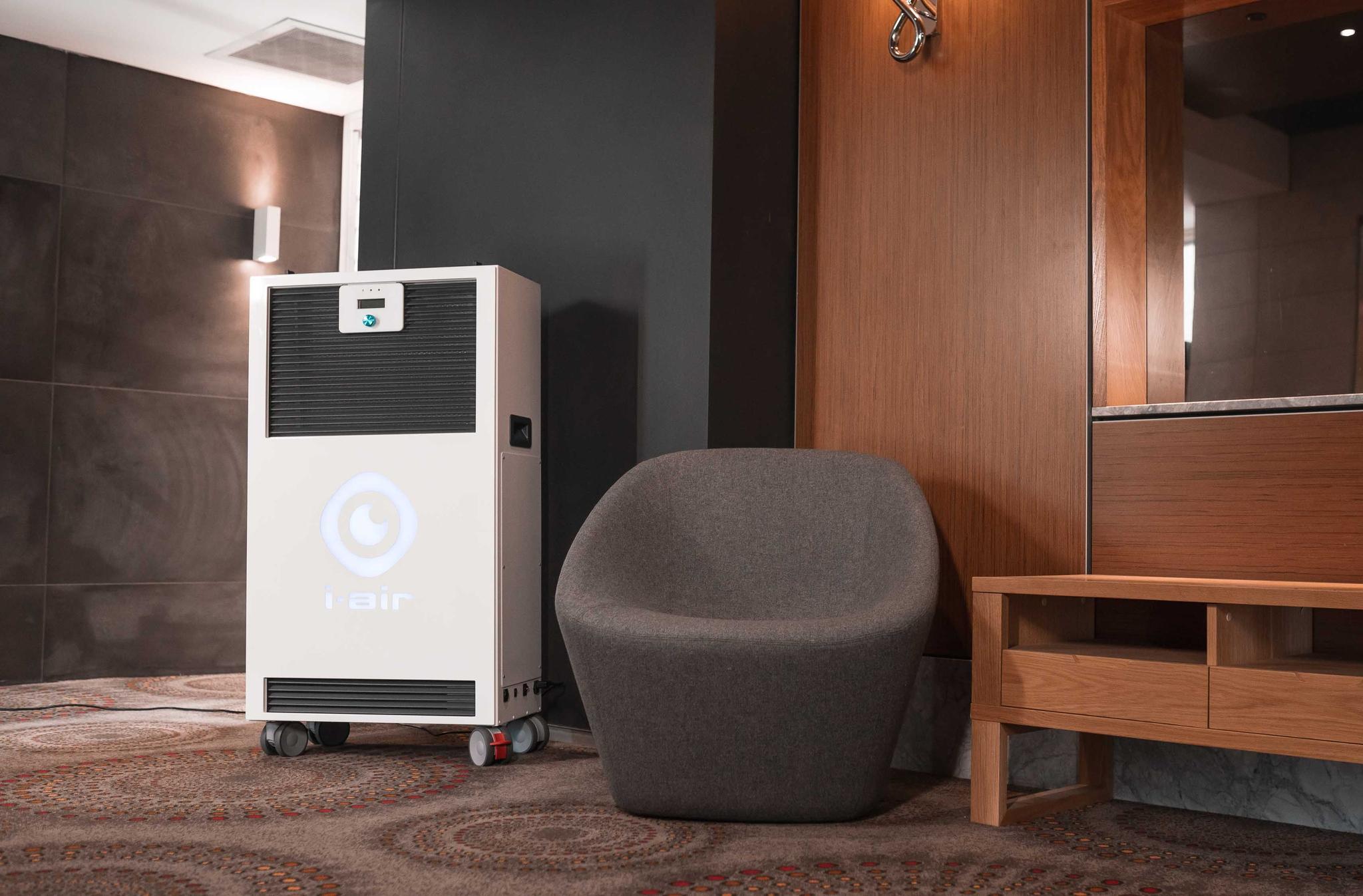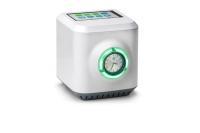You are reading: Five Things to Look for in a Great Commercial Air Purifier
10 August 2022
5min read time
Brooke Payne
Five Things to Look for in a Great Commercial Air Purifier
Share:

Key Insights
- There are many different types of air purifiers on the market that address different air quality issues, which rely on different filtration methods
- Major considerations include the filtration efficiency, clean air delivery rate, filter size, noise levels and control flexibilities
- Filter size is important, because if you purchase an air purifier with a small filter, the filter is going to get clogged faster and will need to be replaced more frequently
When it comes to cleaning the air that we breathe on a commercial scale, not all air purifiers are created equal.
Unpurified air contains a number of pollutants like odours, dust, allergens, and other microscopic particles, and the problems caused by poor air quality can affect the health of your staff, your customers, and ultimately, the productivity of your business.
Certain businesses often have problems with indoor air quality, stemming from activities like manufacturing processes, airborne chemicals, storage conditions, building location, and a number of industry-specific pollutants.
There are many different types of air purifiers on the market that address different air quality issues, which rely on different filtration methods. This raises the question, though, of what is the best commercial air purifier to suit your needs?
To help you in your search for the best possible unit, let’s first talk about five major considerations to take into account while looking for a commercial air purifier, and cover the technology that separates the best commercial air purifiers from the rest of the pack.
These major considerations include the filtration efficiency, clean air delivery rate, filter size, noise levels and control flexibilities, which are essential points to understand before you make a purchase of a commercial air purifier .

Filtration Efficiency
The best air purifiers on the market are designed to address the three main contaminants that affect indoor air quality, and our health.
The first is particulate matter, or P.M. for short. Think of the dust, smoke and dirt that may be floating in the air around you right now. Large particles, otherwise known as PM10, have a diameter of 10 micrometers or less, and is commonly made up to smoke, dust, salts, metals and soot in the air.
Finer particulate matter, otherwise known as PM2.5, refers to the tiny particles floating in the air that measure just 2.5 microns or less; these are so small that a single strand of human hair measures at 30-microns. These smaller particles often originate from the outside world in the form of car exhausts, or ambient smoke in the air from tobacco smoking, cooking and even burning candles.
Next, keep in mind that the best commercial air purifiers can treat volatile organic compounds, otherwise known as V.O.C’s, like the harmful organic contaminants emitted from aerosols, paints and other chemicals. The third comes in the form of biological contaminants such as bacteria, viruses and moulds that can have a huge impact on our health.
Just how effectively an air purifier removes each type of contaminant depends largely on what filtration technology it uses. There's a number of them, so let’s break them down.
EPA filters are the entry-level filter, which remove 95% of particles down to .3um size. For better filtration performance, look for a HEPA filter that’s rated at H13 or better still H14. HEPA 14 filters filter out 99.995% contaminants down to 0.3 microns, so they'll work for the majority of PM contaminants.
Next, we have active carbon filters, which are ideal for capturing large particles and breaking down large volatile organic compounds.
Then, we have UVC lights, which can help to kill significantly smaller microbes and viruses.
Finally, there is photocatalytic oxidation, or PCO. This can filter out a full range of contaminants, right down to ultra-fine contaminants of 0.1 microns or less. Did you know that 90% of all airborne contaminants are less .1 microns- so PCO technology is a super effective filtration method for ultra-fine contaminants.
Clean Air Delivery Rates
Now we know the different types of filters, take note of the purifier’s clean air delivery rate, which refers to the volume of air replaced in an hour; the higher that rating, the quicker you’ll replace all the air in a room.
It’s important to consider not only the effectiveness of the filter, but also how efficiently your commercial air purifier can provide large volumes of clean air in a short period of time. Opting for a unit that provides the largest amount of clean air in the shortest possible time is a good goal, here, although the top-ranking units might create considerable noise that is inappropriate for all environments.
Filter Size
Now, let’s move to the filter size. This is important, because if you purchase an air purifier with a small filter, the filter is going to get clogged faster and will need to be replaced more frequently.
This translates to ongoing maintenance costs, while a larger filter can absorb a lot more particles without needing to replace the filter. So check the recommended filter change intervals.
Smaller units need filter replacement every few weeks, while the best larger units have filters that will last over 12 months. Opting for a commercial air purifier that offers a self-cleaning filter or a low-maintenance schedule is a great way to ensure you won’t have to stop the unit to clean or change filters on a regular basis.
Noise Levels
With the most important things under control, it’s time we moved onto how well the air purifier can fit into your environment and get working away in the background. If you make your purchase solely on clean air delivery rates, you may end up with a unit that produces more noise than you’re prepared to deal with in your environment.
With this in mind, keep an eye on the air purifier’s decibel rating, and be sure to how noise levels will translate to your working space. If the purifier offers different levels of operation, consider how this can be adjusted to avoid disturbing the public or your employees.
Read to learn more about the cleaning power of UV light air purifiers.

Control Flexibilities
Finally, consider what sort of features & controls it has. Things like wifi connectivity make it easy to control from a PC, which can be handy especially if you have multiple units. Don’t place too much importance on smart apps, though, keep it simple and opt for the most effective air purifier; not the ‘smartest’
So, when you’re looking for the best commercial air purifier on the market, consider primarily the filtration efficiency, and opt for a unit with multiple levels of filtration- not just one or two. Take note of the clean air delivery rate and filter size to get a clear picture of efficacy and the required maintenance.
We here at i-team hope that you’ve found this information helpful, and if you have any further questions, please let us know in the comment section below - thank you.
Check out this video from i-team about the i-air Pro commercial air purifier below:
Common Questions Answered
1. What types of filters should a commercial air purifier have?
Answer: A great commercial air purifier should ideally have HEPA filters, which capture 99.97% of particles 0.3 microns and larger, along with activated carbon filters for odor and chemical removal. Some models may also feature pre-filters to extend the lifespan of the main filters.
2. How important is the Clean Air Delivery Rate (CADR)?
Answer: The Clean Air Delivery Rate (CADR) is crucial as it measures how quickly an air purifier can clean the air in a specific room size. A higher CADR indicates a more effective purifier, especially in commercial settings where air quality needs to be maintained quickly.
3. What additional features should I consider in a commercial air purifier?
Answer: Consider features such as air quality sensors, smart technology (like app connectivity), noise levels, and maintenance indicators. These features can enhance usability and ensure the purifier operates effectively in a busy commercial environment.
References
Air Purifier Ratings – Top 5 Features to Look for in an Air Purifier
URL: https://www.airpurifierratings.com/features-to-look-for
Consumer Reports – How to Choose an Air Purifier
URL: https://www.consumerreports.org/air-purifiers/how-to-choose-an-air-purifier
The Spruce – Essential Features of Commercial Air Purifiers
URL: https://www.thespruce.com/commercial-air-purifier-features
See more about the ultimate in commercial indoor air quality
Media and Insights
Join the movement that's changing what clean means.
Be part of a cleaner world. Get a live demo at a time that suits you.
Book a Demo
